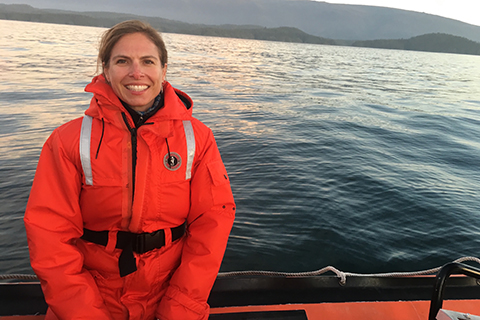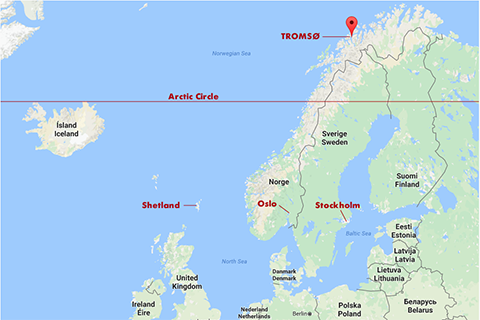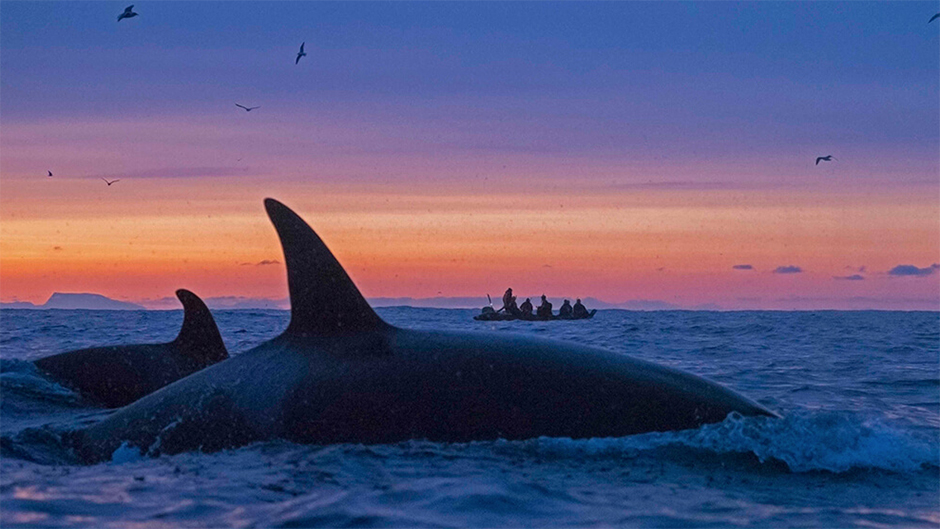A few hours ago and about 5,000 miles away, Natalie Barefoot was to set sail in the Arctic Ocean, where the University of Miami lecturer of law will spend an unusual Thanksgiving week snorkeling with orcas and humpback whales feeding on vast schools of herring in Norway’s northern fjords.
“Thanksgiving is all about celebrating the harvest and we will be celebrating the bountiful herring harvest for orcas and humpbacks who depend on them for survival,” said Barefoot, a certified divemaster and freediver who is the director of the School of Law’s Environmental Justice Clinic.

Barefoot, who earned her law degree at UM in 2005 and specializes in legal protections for cetaceans—whales, porpoises, and dolphins—is a member of an all-female excursion organized by Sedna Epic Expedition, a nonprofit named for the goddess of the sea and mother of all marine mammals in Inuit legend. Comprised of women ocean explorers, scientists, storytellers, artists, educators, and scuba divers, Sedna teams study the Arctic’s disappearing sea ice and engage girls and young women in Inuit and other matrilineal aboriginal communities in the Sedna mission of mitigating global warming by combining scientific and indigenous knowledge.
Which is why Barefoot, who was recently named a faculty scholar of UM’s Abess Center for Ecosystem Science and Policy, was so eager to join Sedna’s Winter Whales of Norway excursion when a research spot opened at the last minute.
“I love translating science and knowledge into policy and protections and when I say knowledge I think of traditions, particularly indigenous traditions, that have been passed on for generations,” said Barefoot, who in 2015 founded the nonprofit Cet Law to advance strategies, policies, laws, and projects that protect cetaceans around the world. “People in the past knew how to protect the Earth. They didn’t necessarily have laws, but they had procedures and sacred practices in place that respected and protected nature.”
During the weeklong voyage aboard the 146-foot MV Freya, which was to leave the Norwegian port city of Tromsø, about 200 miles north of the Arctic Circle, on Tuesday, Barefoot and 19 other women on the Sedna team plan to spend much of their days in dry suits, snorkeling in the frigid Arctic with orcas following the winter herring run. They’ll work in tandem to capture photographic, acoustic, and behavioral data for ongoing research projects on the distinctive black-and-white marine mammals which, weighing up to 10 tons and measuring as long as 30 feet, are the largest members of the dolphin family. Cutting through the water, their dorsal fins can stand as tall as a man.

The women, who include Inuits from Canada and Samis, reindeer herders who have inhabited northern Scandinavia for thousands of years, also will analyze ocean conditions, including conductivity, density and salinity, and the prevalence of micro-plastics and plankton in the water.
Then, as the aurora borealis dances across the northern skies, they’ll spend their evenings sharing their experiences, knowledge, and expertise. In one of her talks, Barefoot will discuss the evolving issues associated with how whale watching is—or isn’t—regulated around the world.
It is a subject she was drawn to after she graduated from Miami Law with an emphasis on environmental law and spent a year in the field with cetacean researchers, tracking, observing and collecting observational, photographic, and acoustic data and DNA samples from whales and dolphins in such places as New Zealand and the Cook Islands. It was there in the South Pacific Ocean that she recognized the need for Cet Law.
“I was really intrigued by the fact that the Cook Islands declared a whale sanctuary in 2001, but never put a single law in place supporting that, so there was this real disconnect between the intent and the reality,” Barefoot recalled. “So that’s how I got interested in working with whale-watching communities around the world to help improve respectful interactions with and protections for whales.”
As the Arctic continues warming with the changing climate, Barefoot says those protections are more important than ever. As she notes, great whales like humpbacks, which can weigh 50 tons and stretch for 62 feet, are among nature’s best carbon mitigators. As the behemoths known for their knobbly heads and spectacular acrobatics leave their mating and breeding grounds and head to their Arctic Circle feeding grounds, their explosive dives and the waste they produce churn up and nourish phytoplankton in the nutrient-poor mid-ocean, enabling the organisms that are the foundation of the aquatic food chain to photosynthesize and remove carbon from the air.
“A heavy and robust population of whales will actually help mitigate climate change,” Barefoot said. “So this is why we need to protect whales and try to increase their populations.”
It is a message she plans to share not only on the MV Freya this week, but virtually with students around the world after she returns to Miami, where for her first Abess Scholars project, she will share her Arctic experiences and knowledge with remote classroom audiences, especially girls who she hopes will be inspired to follow in her flippers, or to a STEM field, one day.

